
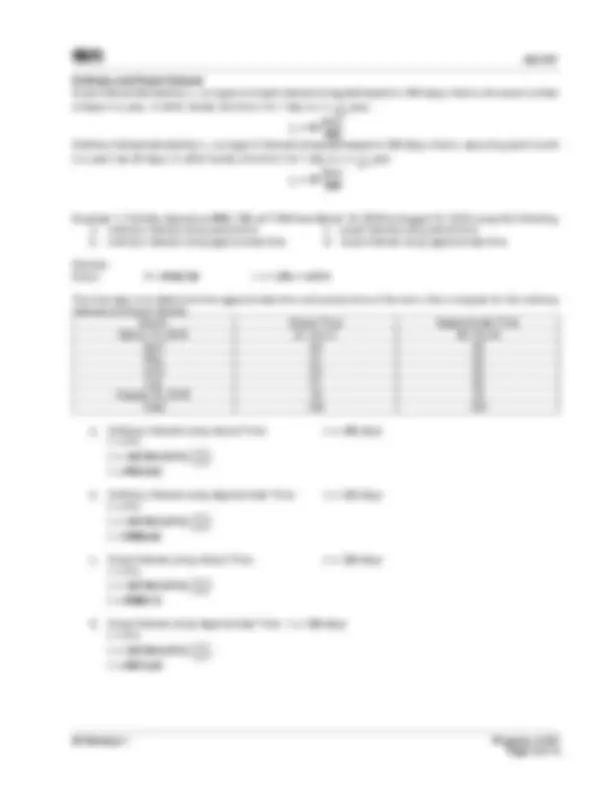
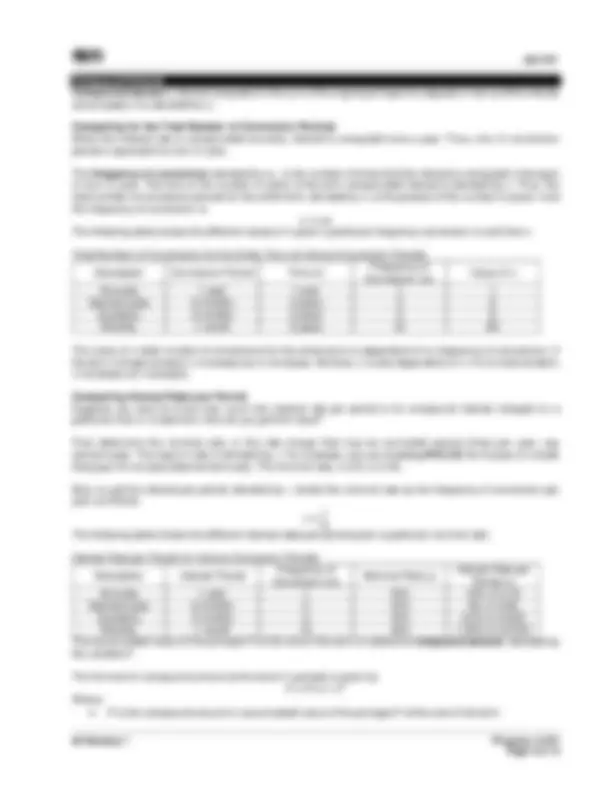
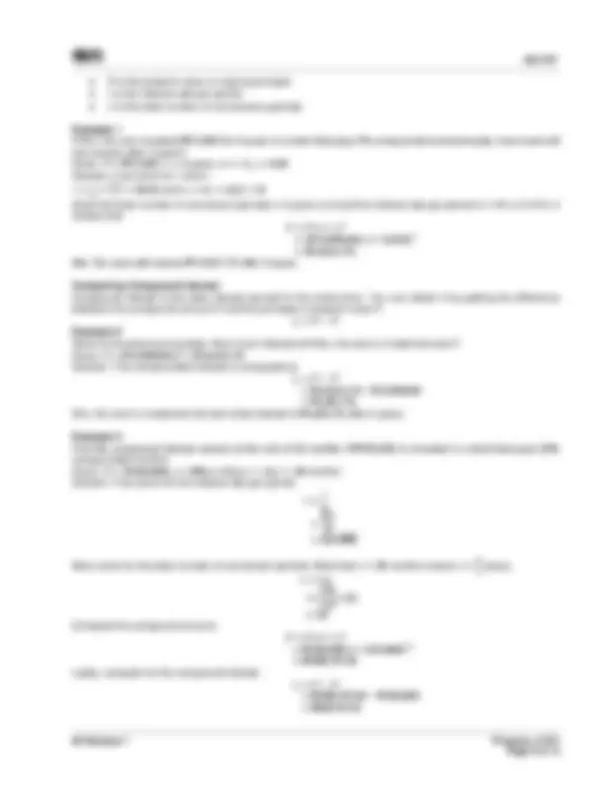
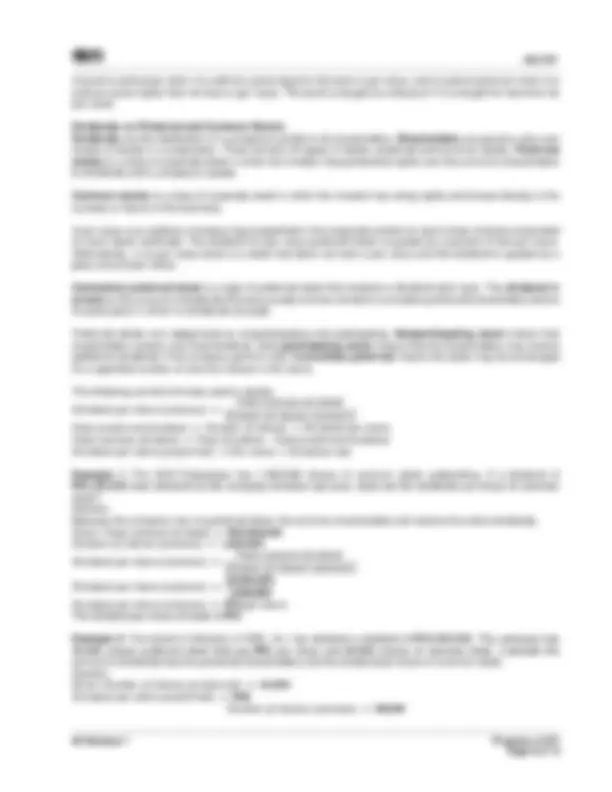
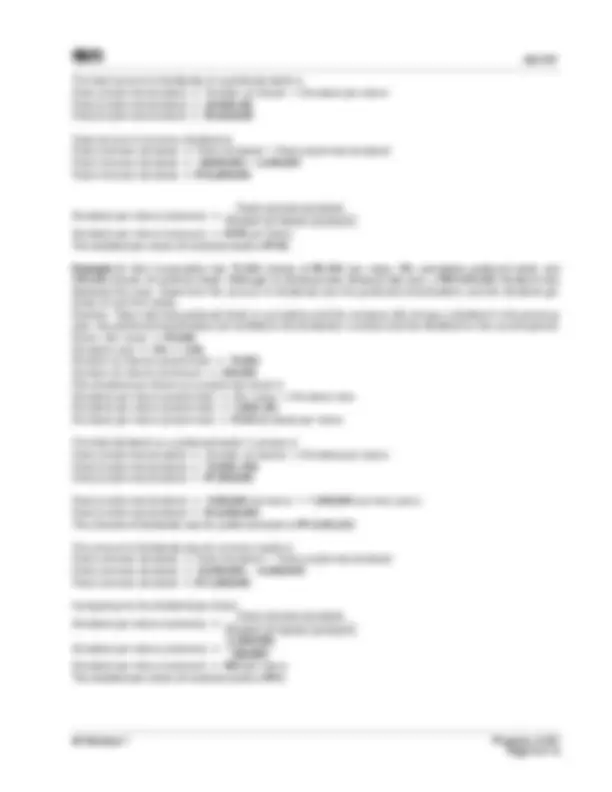
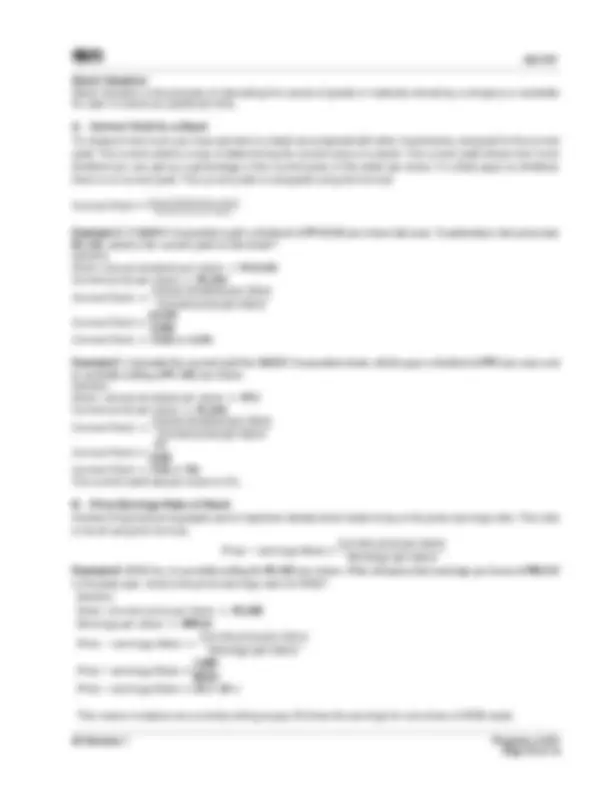
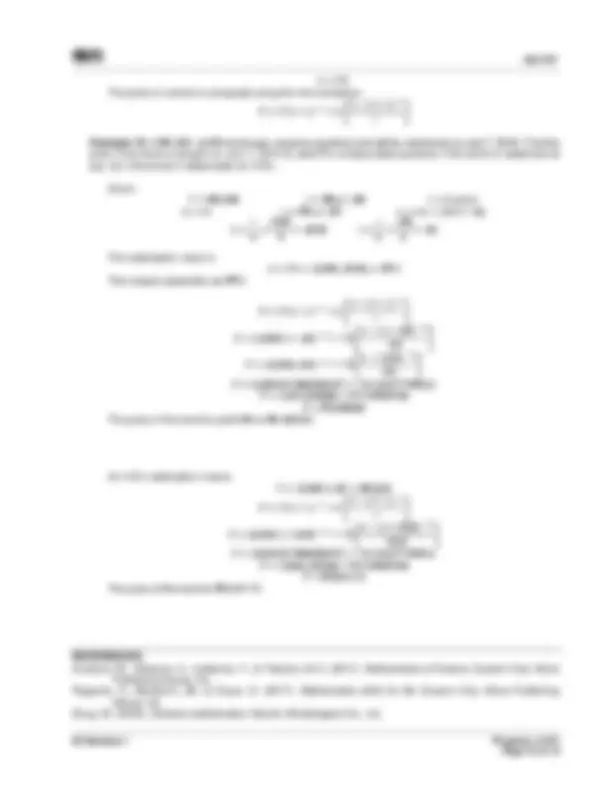


Study with the several resources on Docsity

Earn points by helping other students or get them with a premium plan


Prepare for your exams
Study with the several resources on Docsity

Earn points to download
Earn points by helping other students or get them with a premium plan
Community
Ask the community for help and clear up your study doubts
Discover the best universities in your country according to Docsity users
Free resources
Download our free guides on studying techniques, anxiety management strategies, and thesis advice from Docsity tutors
Handout for MIMW can help for first year college for MIMW
Typology: Summaries
1 / 13

This page cannot be seen from the preview
Don't miss anything!








05 Handout 1 _Property of STI_*
The Mathematics of Finance
Simple Interest Simple Interest
Then the final amount or Maturity value (𝐹𝐹) at the end of 𝐼𝐼 years can be solved using 𝐹𝐹 = 𝑃𝑃 + 𝐼𝐼 Derived Formulas
Example 1: If ₱1,500 was borrowed at 8% simple interest, how much will the interest be for 2 years? Given: 𝑃𝑃 = ₱1,500; 𝐼𝐼 = 8% 𝑜𝑜𝐼𝐼 .08; 𝐼𝐼 = 2 years Find: 𝐼𝐼
Example 2: If ₱300 is the interest at 9% after 4 months, how much was borrowed?
Given: 𝐼𝐼 = ₱300; 𝐼𝐼 = 9% 𝑜𝑜𝐼𝐼 .09; 𝐼𝐼 = 4 12 𝑜𝑜𝐼𝐼^
1 3 year Find: 𝑃𝑃
Example 3: If ₱1,912.50 is the interest for investing ₱9,000 for 2 years and 6 months, find the rate of interest. Given: 𝐼𝐼 = ₱1,912.50; 𝑃𝑃 = ₱9,000; 𝐼𝐼 = 2.5 years Find: 𝐼𝐼
Example 4: Accumulate ₱8,000 for 1 year and 6 months at 10% simple interest. Given: 𝑃𝑃 = ₱8,000; 𝐼𝐼 = 1.5 years;𝐼𝐼 = 10% 𝑜𝑜𝐼𝐼. Find: 𝐹𝐹
05 Handout 1 _Property of STI_*
Simple Discount Discount 𝐷𝐷 is a deduction from maturity amount 𝐹𝐹 of an obligation allowed for paying it currently. The formula is 𝐷𝐷 = 𝐹𝐹𝐹𝐹𝐼𝐼, where: 𝐷𝐷 − discount 𝐹𝐹 − amount of maturity 𝐹𝐹 − discount rate 𝐼𝐼 − time or term of discount
To find 𝑃𝑃, use 𝑃𝑃 = 𝐹𝐹 − 𝐷𝐷 or 𝑃𝑃 = 𝐹𝐹(1 − 𝐹𝐹𝐼𝐼) Derived Formulas are
𝐹𝐹 = 𝐷𝐷 𝐹𝐹𝑟𝑟;^ 𝐼𝐼^ =^
𝐷𝐷 𝐹𝐹𝐹𝐹;^ and^ 𝐹𝐹^ =^
𝐷𝐷 𝐹𝐹𝑟𝑟
Example: Find the present value of ₱2,000, which is due at the end of 90 days at 5% simple discount.
Given: 𝐹𝐹 = ₱2,000; 𝐼𝐼 = 14 ; 𝐹𝐹 =.
Actual Time This is the actual number of days between two (2) dates.
Approximate Time This method considered that there were 30 days in each month or 360 days in one (1) year.
Example 1: A note dated February 28 is due to be paid August 1. How many days will the note run?
Example 2: Find the due date for a 130-day note dated July 7.
Example 3: Determine the actual time and approximate time from March 3, 2015 to September 10, 2015.
05 Handout 1 _Property of STI_*
Compound Interest Compound Interest is interest computed on the sum of the original principal of a deposit or loan and the interest accumulated. It is denoted by 𝐼𝐼𝑐𝑐.
Computing for the Total Number of Conversion Periods When the interest rate is compounded annually, interest is computed once a year. Thus, one (1) conversion period is equivalent to one (1) year.
The frequency of conversion, denoted by 𝑆𝑆 , is the number of times that the interest is computed in the span of one (1) year. The time or the number of years of the term compounded interest is denoted by 𝐼𝐼. Thus, the total number of conversion periods for the entire term, denoted by 𝐼𝐼 , is the product of the number of years 𝐼𝐼 and the frequency of conversion 𝑆𝑆. 𝐼𝐼 = 𝐼𝐼𝑆𝑆 The following table shows the different values of 𝐼𝐼 given a particular frequency conversion 𝑆𝑆 and time 𝐼𝐼.
Total Number of Conversions for the Entire Term at Various Conversion Periods
Description Conversion Period Time (𝐼𝐼) Frequency of Conversion (𝑆𝑆) Value of 𝐼𝐼 Annually 1 year 1 year 1 1 Semiannually 6 months 3 years 2 6 Quarterly 3 months 2 years 4 8 Monthly 1 month 5 years 12 60
The value of 𝐼𝐼 (total number of conversions for the entire term) is dependent of 𝑆𝑆 (frequency of conversion). If the term 𝐼𝐼 is kept constant, 𝐼𝐼 increases as 𝑆𝑆 increases. Similarly, 𝐼𝐼 is also dependent on 𝐼𝐼. If 𝑆𝑆 is held constant, 𝐼𝐼 increases at 𝐼𝐼 increases.
Computing Interest Rates per Period Suppose you want to know how much the interest rate per period is for compound interest charged on a particular loan or investment. How do you get this value?
First, determine the nominal rate, or the rate charge that may be converted several times per year, say semiannually. This type of rate is denoted by 𝑗𝑗. For example, you are investing ₱36,000 for 5 years in a bank that pays 3% compounded semiannually. The nominal rate 𝑗𝑗 is 3% or 0.03.
Now, to get the interest per period, denoted by 𝑆𝑆, divide the nominal rate by the frequency of conversion per year as follows:
𝑆𝑆 =
The following table shows the different interest rates per period given a particular nominal rate:
Interest Rate per Period for Various Conversion Periods
Description Interest Period Frequency of Conversion (𝑆𝑆) Nominal Rate (𝑗𝑗) Interest Rate per Period (𝑆𝑆) Annually 1 year 1 10% 10% or 0. Semiannually 6 months 2 12% 6% or 0. Quarterly 3 months 4 14% 3.5% or 0. Monthly 1 month 12 16% 1.33% or 0. The accumulated value of the principal 𝑃𝑃 at the end of the term is called the compound amount , denoted by the variable 𝐹𝐹.
The formula for compound amount at the end of 𝐼𝐼 periods is given by 𝐹𝐹 = 𝑃𝑃(1 + 𝑆𝑆)𝑛𝑛 Where:
05 Handout 1 _Property of STI_*
Example 1 If Mrs. De Leon invested ₱12,900 for 4 years in a bank that pays 3% compounded semiannually, how much will she receive after 4 years? Given: 𝑃𝑃 = ₱12,900; 𝐼𝐼 = 4 years; 𝑆𝑆 = 2; 𝑗𝑗 = 0. 03 Solution: First solve for 𝑆𝑆 and 𝐼𝐼.
𝑆𝑆 = 𝑗𝑗 𝑚𝑚 =^
Computing Compound Interest Compound interest is the total interest earned for the entire term. You can obtain it by getting the difference between the compound amount 𝐹𝐹 and the principal or present value 𝑃𝑃. 𝐼𝐼𝑐𝑐 = 𝐹𝐹 − 𝑃𝑃 Example 2 Refer to the previous example. How much interest will Mrs. De Leon’s investment earn? Given: 𝑃𝑃 = ₱12,900.00; 𝐹𝐹 = ₱14, 531. Solution: The compounded interest is computed as 𝐼𝐼𝑐𝑐 = 𝐹𝐹 − 𝑃𝑃 = ₱14, 531 .75 − ₱12,900. = ₱1, 631 .75. Mrs. De Leon’s investment will earn total interest of ₱1, 631 .75 after 4 years.
Example 3 Find the compound interest earned at the end of 20 months if ₱150,000 is invented in a fund that pays 20% compounded monthly. Given: 𝑃𝑃 = ₱150,000; 𝑗𝑗 = 20% 𝑜𝑜𝐼𝐼 0.2; 𝑆𝑆 = 12; 𝐼𝐼 = 20 months’ Solution: First solve for the interest rate per period.
𝑆𝑆 =
Next, solve for the total number of conversion periods. Note that 𝐼𝐼 = 20 months means 𝐼𝐼 = 20 12 years. 𝐼𝐼 = 𝐼𝐼𝑆𝑆 = �
Compute the compound amount. 𝐹𝐹 = 𝑃𝑃(1 + 𝑆𝑆)𝑛𝑛 = ₱150,000(1 + 0. 01666 )^20 = ₱208, 767. 53 Lastly, compute for the compound interest. 𝐼𝐼𝑐𝑐 = 𝐹𝐹 − 𝑃𝑃 = ₱208, 767 .53 − ₱150, = ₱58, 767. 53
05 Handout 1 _Property of STI_*
Another way to solve the problem is by using the equivalent formula for 𝑃𝑃, 𝑃𝑃 = 𝐹𝐹(1 + 𝑆𝑆)−𝑛𝑛 = ₱35,000(1 + 0. 03 )− = ₱35,000(1. 03 )− = ₱14, 419. 54 The present value of ₱35,000.00 that is due at the end of 7.5 years is ₱14,419.54.
Example 7 A certain principal 𝑃𝑃 was invested at 6% compounded semiannually. If this principal amounted to ₱94,500 at the end of 3 years, how much was the principal? Find the compound interest earned. Given: 𝐹𝐹 = ₱94,500; 𝐼𝐼 = 3 𝑑𝑑𝑆𝑆𝑃𝑃𝐼𝐼𝐼𝐼; 𝑗𝑗 = 6% 𝑜𝑜𝐼𝐼 0. 06 ; 𝑆𝑆 = 2 Solution: Solve first for 𝑆𝑆 and 𝐼𝐼.
𝑆𝑆 =
Use the values of 𝐹𝐹, 𝑆𝑆 and 𝐼𝐼 to solve for 𝑃𝑃. 𝑃𝑃 = 𝐹𝐹(1 + 𝑆𝑆)−𝑛𝑛 = ₱94,500.00(1 + 0. 03 )− = ₱79, 142. 26 The compound interest 𝐼𝐼𝑐𝑐 is then computed as 𝐼𝐼𝑐𝑐 = 𝐹𝐹 − 𝑃𝑃 = ₱94,500.00 − ₱79, 142. 26 = ₱15, 357. 74 The present value of ₱94,500.00 that is due at the end of 3 years is ₱79, 142.26. The compounded interest that the investment earned is ₱15,357.74.
Stocks and Bonds Stocks A stock is a type of security that signifies ownership in a corporation and represents a claim on part of the corporation’s assets and earnings. Stocks are classified into two (2) types: the common stock and the preferred stock.
In the Philippines, stocks are traded regularly at various marketplaces such as Philippines Stock Exchange (PSE) and Market Stock Exchange (MSE). These are places where an investor can buy or sell stocks through a licensed broker authorized to transact business in the market stock places.
Bonds A bond is a certificate or a written contract in which the debtor promises to pay its holder a specified amount of money, plus a certain rate of interest at a stated future date.
A company that needs money can borrow from investors by selling bonds. A bond is a debt covering a long term such as 10, 20 or more years. The investor is the bondholder who is guaranteed to be repaid at a specified future date.
Typical bonds which are issued in various denominators are payable at par value or face value at maturity date. The par value or face value is the principal borrowed as stated in the bond.
The par value is usually the price the investor pays when buying the bond from the issuing company. An investor may sell the bond at any time to another investor.
Bonds are traded among investors. Hence, the value of a bond fluctuates up and down during its lifetime, depending on how many investors are willing to pay for it. The amount the investor actually pays for the bond is called the market.
05 Handout 1 _Property of STI_*
A bond is sold at par when it is sold at a price equal to the face or par value, and is sold at premium when it is sold at a price higher than its face or par value. The bond is bought at a discount if it is bought for less than its par value.
Dividends on Preferred and Common Stocks Dividends are the distribution of a company’s profits to its shareholders. Shareholders are persons who own shares of stocks in a corporation. There are two (2) types of stocks: preferred and common stocks. Preferred stocks is a class of corporate stock in which the investor has preferential rights over the common shareholders to dividends and a company’s assets.
Common stocks is a class of corporate stock in which the investor has voting rights and shares directly in the success or failure of the business.
A par value is an arbitrary monetary figure specified in the corporate charter for each share of stock and printed on each stock certificate. The dividend for par value preferred stock is quoted as a percent of the par value. Alternatively, a no-par value stock is a stock that does not have a par value and the dividend is quoted as a peso amount per share.
Cumulative preferred stock is a type of preferred stock that receives a dividend each year. The dividend in arrears is the amount of dividends that accumulate and are owned to cumulative preferred shareholders before for past years in which no dividends are paid.
Preferred stocks are categorized as nonparticipating and participating. Nonparticipating stock means that shareholders receive only fixed dividend, while participating stock means that the shareholders may receive additional dividends if the company perform well. Convertible preferred means the stock may be exchanged for a specified number of common shares in the future.
The following are the formulas used in stocks:
𝐷𝐷𝑆𝑆𝐷𝐷𝑆𝑆𝐹𝐹𝑆𝑆𝐼𝐼𝐹𝐹 𝑆𝑆𝑆𝑆𝐼𝐼 𝐼𝐼ℎ𝑃𝑃𝐼𝐼𝑆𝑆 (𝑃𝑃𝑜𝑜𝑆𝑆𝑆𝑆𝑜𝑜𝐼𝐼) =
Example 1: The AUS Enterprises has 1,500,000 shares of common stock outstanding. If a dividend of ₱30,000,000 was declared by the company directors last year, what are the dividends per share of common stock? Solution: Because the company has no preferred stock, the common shareholders will receive the entire dividends. Given: 𝑇𝑇𝑜𝑜𝐼𝐼𝑃𝑃𝑆𝑆 𝑃𝑃𝑜𝑜𝑆𝑆𝑆𝑆𝑜𝑜𝐼𝐼 𝐹𝐹𝑆𝑆𝐷𝐷𝑆𝑆𝐹𝐹𝑆𝑆𝐼𝐼𝐹𝐹 = ₱30,000, 𝑁𝑁𝑁𝑁𝑆𝑆𝑁𝑁𝑆𝑆𝐼𝐼 𝑜𝑜𝑜𝑜 𝐼𝐼ℎ𝑃𝑃𝐼𝐼𝑆𝑆𝐼𝐼 (𝑃𝑃𝑜𝑜𝑆𝑆𝑆𝑆𝑜𝑜𝐼𝐼) = 1,500,
𝐷𝐷𝑆𝑆𝐷𝐷𝑆𝑆𝐹𝐹𝑆𝑆𝐼𝐼𝐹𝐹 𝑆𝑆𝑆𝑆𝐼𝐼 𝐼𝐼ℎ𝑃𝑃𝐼𝐼𝑆𝑆 (𝑃𝑃𝑜𝑜𝑆𝑆𝑆𝑆𝑜𝑜𝐼𝐼) =
The dividend per share of stock is ₱
Example 2: The board of directors of SSS, Inc. has declared a dividend of ₱18,000,000. The company has 40,000 shares preferred stock that pay ₱60 per share and 80,000 shares of common stock. Calculate the amount of dividends due the preferred shareholders and the dividend per share of common stock. Solution: 𝐺𝐺𝑆𝑆𝐷𝐷𝑆𝑆𝐼𝐼: 𝑁𝑁𝑁𝑁𝑆𝑆𝑁𝑁𝑆𝑆𝐼𝐼 𝑜𝑜𝑜𝑜 𝐼𝐼ℎ𝑃𝑃𝐼𝐼𝑆𝑆𝐼𝐼 (𝑆𝑆𝐼𝐼𝑆𝑆𝑜𝑜𝑆𝑆𝐼𝐼𝐼𝐼𝑆𝑆𝐹𝐹) = 40 , 𝐷𝐷𝑆𝑆𝐷𝐷𝑆𝑆𝐹𝐹𝑆𝑆𝐼𝐼𝐹𝐹 𝑆𝑆𝑆𝑆𝐼𝐼 𝐼𝐼ℎ𝑃𝑃𝐼𝐼𝑆𝑆 (𝑆𝑆𝐼𝐼𝑆𝑆𝑜𝑜𝑆𝑆𝐼𝐼𝐼𝐼𝑆𝑆𝐹𝐹) = ₱ 𝑁𝑁𝑁𝑁𝑆𝑆𝑁𝑁𝑆𝑆𝐼𝐼 𝑜𝑜𝑜𝑜 𝐼𝐼ℎ𝑃𝑃𝐼𝐼𝑆𝑆𝐼𝐼 (𝑃𝑃𝑜𝑜𝑆𝑆𝑆𝑆𝑜𝑜𝐼𝐼) = 80,
05 Handout 1 _Property of STI_*
Stock Valuation Stock Valuation is the process of calculating the values of goods or materials owned by a company or available for sale in a store at a particular time.
A. Current Yield for a Stock
To measure how much you have earned on a stock as compared with other investments, compute for the current yield. The current yield is a way of determining the current value of a stock. The current yield shows how much dividend you can get as a percentage of the current price of the stock per share. If a stock pays no dividend, there is no current yield. The current yield is computed using the formula:
Example 4 : If MMDN Corporation paid a dividend of ₱142.60 per share last year. If yesterday’s last price was ₱2,300, what is the current yield on the stock? Solution: Given: 𝐴𝐴𝐼𝐼𝐼𝐼𝑁𝑁𝑃𝑃𝑆𝑆 𝐹𝐹𝑆𝑆𝐷𝐷𝑆𝑆𝐹𝐹𝑆𝑆𝐼𝐼𝐹𝐹 𝑆𝑆𝑆𝑆𝐼𝐼 𝐼𝐼ℎ𝑃𝑃𝐼𝐼𝑆𝑆 = ₱142. 60 𝐶𝐶𝑁𝑁𝐼𝐼𝐼𝐼𝑆𝑆𝐼𝐼𝐼𝐼 𝑆𝑆𝐼𝐼𝑆𝑆𝑃𝑃𝑆𝑆 𝑆𝑆𝑆𝑆𝐼𝐼 𝐼𝐼ℎ𝑃𝑃𝐼𝐼𝑆𝑆 = ₱2, 300
𝐶𝐶𝑁𝑁𝐼𝐼𝐼𝐼𝑆𝑆𝐼𝐼𝐼𝐼 𝑌𝑌𝑆𝑆𝑆𝑆𝑆𝑆𝐹𝐹 =
Example 5 : Calculate the current yield for MMDN Corporation stock, which pays a dividend of ₱70 per year and is currently selling at ₱1,400 per share. Solution: Given: 𝐴𝐴𝐼𝐼𝐼𝐼𝑁𝑁𝑃𝑃𝑆𝑆 𝐹𝐹𝑆𝑆𝐷𝐷𝑆𝑆𝐹𝐹𝑆𝑆𝐼𝐼𝐹𝐹 𝑆𝑆𝑆𝑆𝐼𝐼 𝐼𝐼ℎ𝑃𝑃𝐼𝐼𝑆𝑆 = ₱ 𝐶𝐶𝑁𝑁𝐼𝐼𝐼𝐼𝑆𝑆𝐼𝐼𝐼𝐼 𝑆𝑆𝐼𝐼𝑆𝑆𝑃𝑃𝑆𝑆 𝑆𝑆𝑆𝑆𝐼𝐼 𝐼𝐼ℎ𝑃𝑃𝐼𝐼𝑆𝑆 = ₱1, 400
𝐶𝐶𝑁𝑁𝐼𝐼𝐼𝐼𝑆𝑆𝐼𝐼𝐼𝐼 𝑌𝑌𝑆𝑆𝑆𝑆𝑆𝑆𝐹𝐹 =
The current yield rate per share is 5%.
B. Price-Earnings Ratio of Stock Another thing that some people use to help them decide which stock to buy is the price-earnings ratio. This ratio is found using the formula:
𝑃𝑃𝐼𝐼𝑆𝑆𝑃𝑃𝑆𝑆 − 𝑆𝑆𝑃𝑃𝐼𝐼𝐼𝐼𝑆𝑆𝐼𝐼𝑒𝑒𝐼𝐼 𝑅𝑅𝑃𝑃𝐼𝐼𝑆𝑆𝑜𝑜 =
Example 6 : WSS Inc. is currently selling for ₱2,685 per share. If the company had earnings per share of ₱89. in the past year, what is the price-earnings ratio for WSS? Solution: Given: 𝐶𝐶𝑁𝑁𝐼𝐼𝐼𝐼𝑆𝑆𝐼𝐼𝐼𝐼 𝑆𝑆𝐼𝐼𝑆𝑆𝑃𝑃𝑆𝑆 𝑆𝑆𝑆𝑆𝐼𝐼 𝐼𝐼ℎ𝑃𝑃𝐼𝐼𝑆𝑆 = ₱2, 685 𝐸𝐸𝑃𝑃𝐼𝐼𝐼𝐼𝑆𝑆𝐼𝐼𝑒𝑒𝐼𝐼 𝑆𝑆𝑆𝑆𝐼𝐼 𝐼𝐼ℎ𝑃𝑃𝐼𝐼𝑆𝑆 = ₱89.
𝑃𝑃𝐼𝐼𝑆𝑆𝑃𝑃𝑆𝑆 − 𝑆𝑆𝑃𝑃𝐼𝐼𝐼𝐼𝑆𝑆𝐼𝐼𝑒𝑒𝐼𝐼 𝑅𝑅𝑃𝑃𝐼𝐼𝑆𝑆𝑜𝑜 =
This means investors are currently willing to pay 30 times the earnings for one share of WSS stock.
05 Handout 1 _Property of STI_*
Example 7 : Sofia would like to own stocks in SSS and GSIS, but she does not know if either stock is a good buy. One thing she can do is to look at the price-earnings ratio for each. a. SSS, price share ₱2,464, annual net income per share ₱88, and b. GSIS, price share ₱1,900, annual net income per share ₱76. Solution: Use the formula for price-earnings ratio to get a. Price-earnings ratio for SSS Given: 𝐶𝐶𝑁𝑁𝐼𝐼𝐼𝐼𝑆𝑆𝐼𝐼𝐼𝐼 𝑆𝑆𝐼𝐼𝑆𝑆𝑃𝑃𝑆𝑆 𝑆𝑆𝑆𝑆𝐼𝐼 𝐼𝐼ℎ𝑃𝑃𝐼𝐼𝑆𝑆 = ₱2, 464
𝑃𝑃𝐼𝐼𝑆𝑆𝑃𝑃𝑆𝑆 − 𝑆𝑆𝑃𝑃𝐼𝐼𝐼𝐼𝑆𝑆𝐼𝐼𝑒𝑒𝐼𝐼 𝑅𝑅𝑃𝑃𝐼𝐼𝑆𝑆𝑜𝑜 =
The price-earnings ratio of SSS stock is 28 times per share. b. Price-earnings ratio for GSIS Given: 𝐶𝐶𝑁𝑁𝐼𝐼𝐼𝐼𝑆𝑆𝐼𝐼𝐼𝐼 𝑆𝑆𝐼𝐼𝑆𝑆𝑃𝑃𝑆𝑆 𝑆𝑆𝑆𝑆𝐼𝐼 𝐼𝐼ℎ𝑃𝑃𝐼𝐼𝑆𝑆 = ₱1,
𝑃𝑃𝐼𝐼𝑆𝑆𝑃𝑃𝑆𝑆 − 𝑆𝑆𝑃𝑃𝐼𝐼𝐼𝐼𝑆𝑆𝐼𝐼𝑒𝑒𝐼𝐼 𝑅𝑅𝑃𝑃𝐼𝐼𝑆𝑆𝑜𝑜 =
The price-earnings ratio of GSIS stock is 25 times per share.
The price-earnings ratio is not a perfect guide to future market behavior of a stock. Occasionally a low price- earnings ratio implies that the stock is undervalued in the market-in order words a good buy. At times a low price-earnings ratio denotes that investors see a poor future for the company.
C. Cost, Proceeds, and Gain (or loss) of a Stock Proceeds are the amount of money that an investor receives after selling a stock. It is computed as the value of shares less the broker’s commission. The stockbroker’s commission is the fee charges for assisting in the purchase or sale of shares of stocks; percent of the cost of the stock transaction. A stockbroker is a professional in stock market trading and investment who acts as an agent in the selling and buying of stocks or other securities. The gain (or loss) is the difference between the cost of purchasing the stock and the proceeds and received when selling the stock.
One more factor affecting the commission is whether the amount of shares purchased is a round lot (multiple of 100 shares), or an odd lot (less than 100 shares). The commission rate on a round lot is generally a bit lower than an odd lot.
The following formula will be used: 𝐶𝐶𝑜𝑜𝐼𝐼𝐼𝐼 𝑜𝑜𝑜𝑜 𝑆𝑆ℎ𝑃𝑃𝐼𝐼𝑆𝑆𝐼𝐼 = 𝑃𝑃𝐼𝐼𝑆𝑆𝑃𝑃𝑆𝑆 𝑆𝑆𝑆𝑆𝐼𝐼 𝐼𝐼ℎ𝑃𝑃𝐼𝐼𝑆𝑆 × 𝑁𝑁𝑁𝑁𝑆𝑆𝑁𝑁𝑆𝑆𝐼𝐼 𝑜𝑜𝑜𝑜 𝐼𝐼ℎ𝑃𝑃𝐼𝐼𝑆𝑆𝐼𝐼 𝐵𝐵𝐼𝐼𝑜𝑜𝑠𝑠𝑆𝑆𝐼𝐼′𝐼𝐼𝑃𝑃𝑜𝑜𝑆𝑆𝑆𝑆𝑆𝑆𝐼𝐼𝑆𝑆𝑜𝑜𝐼𝐼 = 𝐶𝐶𝑜𝑜𝐼𝐼𝐼𝐼 𝑜𝑜𝑜𝑜 𝐼𝐼ℎ𝑃𝑃𝐼𝐼𝑆𝑆𝐼𝐼 × 𝐶𝐶𝑜𝑜𝑆𝑆𝑆𝑆𝑆𝑆𝐼𝐼𝑆𝑆𝑜𝑜𝐼𝐼 𝐼𝐼𝑃𝑃𝐼𝐼𝑆𝑆 𝑇𝑇𝑜𝑜𝐼𝐼𝑃𝑃𝑆𝑆 𝑃𝑃𝑜𝑜𝐼𝐼𝐼𝐼 = 𝐶𝐶𝑜𝑜𝐼𝐼𝐼𝐼 𝑜𝑜𝑜𝑜 𝐼𝐼ℎ𝑃𝑃𝐼𝐼𝑆𝑆𝐼𝐼 + 𝑇𝑇𝑜𝑜𝐼𝐼𝑃𝑃𝑆𝑆 𝐵𝐵𝐼𝐼𝑜𝑜𝑠𝑠𝑆𝑆𝐼𝐼′𝐼𝐼 𝑃𝑃𝑜𝑜𝑆𝑆𝑆𝑆𝑆𝑆𝐼𝐼𝑆𝑆𝑜𝑜𝐼𝐼 𝑉𝑉𝑃𝑃𝑆𝑆𝑁𝑁𝑆𝑆 𝑜𝑜𝑜𝑜 𝐼𝐼ℎ𝑃𝑃𝐼𝐼𝑆𝑆𝐼𝐼 = 𝑃𝑃𝐼𝐼𝑆𝑆𝑃𝑃𝑆𝑆 𝑆𝑆𝑆𝑆𝐼𝐼 𝐼𝐼ℎ𝑃𝑃𝐼𝐼𝑆𝑆 × 𝑁𝑁𝑁𝑁𝑆𝑆𝑁𝑁𝑆𝑆𝐼𝐼 𝑜𝑜𝑜𝑜 𝐼𝐼ℎ𝑃𝑃𝐼𝐼𝑆𝑆𝐼𝐼 𝑃𝑃𝐼𝐼𝑜𝑜𝑃𝑃𝑆𝑆𝑆𝑆𝐹𝐹𝐼𝐼 = 𝑉𝑉𝑃𝑃𝑃𝑃𝑆𝑆𝑁𝑁𝑆𝑆 𝑜𝑜𝑜𝑜 𝐼𝐼ℎ𝑃𝑃𝐼𝐼𝑆𝑆𝐼𝐼 − 𝑇𝑇𝑜𝑜𝐼𝐼𝑃𝑃𝑆𝑆 𝐵𝐵𝐼𝐼𝑜𝑜𝑠𝑠𝑆𝑆𝐼𝐼′𝐼𝐼 𝑃𝑃𝑜𝑜𝑆𝑆𝑆𝑆𝐼𝐼𝐼𝐼𝑆𝑆𝑜𝑜𝐼𝐼 𝐺𝐺𝑃𝑃𝑆𝑆𝐼𝐼 (𝑜𝑜𝐼𝐼 𝑆𝑆𝑜𝑜𝐼𝐼𝐼𝐼) 𝑜𝑜𝐼𝐼 𝐼𝐼𝐼𝐼𝑃𝑃𝐼𝐼𝐼𝐼𝑃𝑃𝑃𝑃𝐼𝐼𝑆𝑆𝑜𝑜𝐼𝐼 = 𝑃𝑃𝐼𝐼𝑜𝑜𝑃𝑃𝑆𝑆𝑆𝑆𝐹𝐹𝐼𝐼 − 𝑇𝑇𝑜𝑜𝐼𝐼𝑃𝑃𝑆𝑆 𝐶𝐶𝑜𝑜𝐼𝐼𝐼𝐼
Example 8 : Shiela purchased 250 shares of AUS Inc. common stock at ₱3,500 per share. A few months later, you sell the shares at ₱4,000. Her stockbroker charges 3% commission on round lots and 4% on odd lots. Calculate the (a) total cost, (b) the proceeds, and (c) the gain or loss on the transaction.
Solution: Given: Price per share = ₱3,500 Commission rate (round lots) =3%=0. Number of shares = 250 Commission rate (odd lots) =4%=0. a. Cost of purchasing stock 𝐶𝐶𝑜𝑜𝐼𝐼𝐼𝐼 𝑜𝑜𝑜𝑜 𝐼𝐼ℎ𝑃𝑃𝐼𝐼𝑆𝑆𝐼𝐼 = 𝑃𝑃𝐼𝐼𝑆𝑆𝑃𝑃𝑆𝑆 𝑆𝑆𝑆𝑆𝐼𝐼 𝐼𝐼ℎ𝑃𝑃𝐼𝐼𝑆𝑆 × 𝑁𝑁𝑁𝑁𝑆𝑆𝑁𝑁𝑆𝑆𝐼𝐼 𝑜𝑜𝑜𝑜 𝐼𝐼ℎ𝑃𝑃𝐼𝐼𝑆𝑆𝐼𝐼 = 3 ,500(250) = ₱875, 𝐵𝐵𝐼𝐼𝑜𝑜𝑠𝑠𝑆𝑆𝐼𝐼′𝐼𝐼 𝐶𝐶𝑜𝑜𝑆𝑆𝑆𝑆𝑆𝑆𝐼𝐼𝐼𝐼𝑆𝑆𝑜𝑜𝐼𝐼 = 𝐶𝐶𝑜𝑜𝐼𝐼𝐼𝐼 𝑜𝑜𝑜𝑜 𝐼𝐼ℎ𝑃𝑃𝐼𝐼𝑆𝑆𝐼𝐼 × 𝐶𝐶𝑜𝑜𝑆𝑆𝑆𝑆𝑆𝑆𝐼𝐼𝐼𝐼𝑆𝑆𝑜𝑜𝐼𝐼 𝐼𝐼𝑃𝑃𝐼𝐼𝑆𝑆 𝑅𝑅𝑜𝑜𝑁𝑁𝐼𝐼𝐹𝐹 𝑆𝑆𝑜𝑜𝐼𝐼 𝑃𝑃𝑜𝑜𝑆𝑆𝑆𝑆𝑆𝑆𝐼𝐼𝐼𝐼𝑆𝑆𝑜𝑜𝐼𝐼 = 200 𝐼𝐼ℎ𝑃𝑃𝐼𝐼𝑆𝑆𝐼𝐼 × 3 ,500 × 0. 03 = ₱21,
05 Handout 1 _Property of STI_*
The price of a bond is computed using the formula below:
𝑃𝑃 = 𝑉𝑉(1 + 𝑆𝑆)−𝑛𝑛^ + 𝑠𝑠 �
Example 10: A ₱3,200, at 9% bond pays coupons quarterly and will be redeemed on July 7, 2016. Find the price if the bond is bought on July 7, 2012 to yield 8% compounded quarterly if the bond is redeemed at par, (b) if the bond if redeemable at 110%.
Given: 𝑉𝑉 = ₱3,200 𝑗𝑗 = 8% 𝑜𝑜𝐼𝐼 .08 𝐼𝐼 = 4 𝑑𝑑𝑆𝑆𝑃𝑃𝐼𝐼𝐼𝐼 𝑆𝑆 = 4 𝐼𝐼 = 9% 𝑜𝑜𝐼𝐼 .09 𝐼𝐼 = 𝐼𝐼𝑆𝑆 = 4 ( 4 = 16 ) 𝑁𝑁 =
The redemption value is 𝑠𝑠 = 𝐹𝐹𝑁𝑁 = 3 ,200(. 0225) = ₱ The coupon payments are ₱72.
The price of the bond to yield 8% is ₱3,308.62.
At 110% redemption means 𝑉𝑉 = 3 ,200(1.10) = ₱3,
𝑃𝑃 = 𝑉𝑉(1 + 𝑆𝑆)−𝑛𝑛^ + 𝑠𝑠 �
The price of the bond is ₱3,541.72.
Cordova, W., Gotauco, C., Ledesma, F., & Tabuloc, M.C. (2017). Mathematics of finance. Quezon City: Abiva Publishing House, Inc. Regacho, C., Benjamin, JB., & Oryan, S. (2017). Mathematics skills for life. Quezon City: Abiva Publishing House, Inc. Sirug, W. (2016). General mathematics. Manila: Mindshapers Co., Inc.